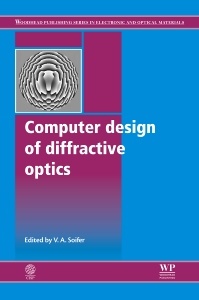Computer Design of Diffractive Optics Woodhead Publishing Series in Electronic and Optical Materials Series

The theoretical aspects underpinning diffractive optics are initially explored, including the main equations in diffraction theory and diffractive optical transformations. Application of electromagnetic field theory for calculating diffractive gratings and related methods in micro-optics are discussed, as is analysis of transverse modes of laser radiation and the formation of self-replicating multimode laser beams. Key applications of DOEs reviewed include geometrical optics approximation, scalar approximation and optical manipulation of micro objects, with additional consideration of multi-order DOEs and synthesis of DOEs on polycrystalline diamond films.
With its distinguished editor and respected team of expert contributors, Computer design of diffractive optics is a comprehensive reference tool for professionals and academics working in the field of optical engineering and photonics.
Preface
Chapter 1: Main equations of diffraction theory
1.1 Maxwell equations
1.2 Differential equations in optics
1.3 Integral optics theorems
1.4 Integral transforms in optics
1.5 Methods for solving the direct diffraction problem
Conclusion
Chapter 2: Diffractive optical transformations
2.1 Transformations in optical systems
2.2 Diffraction gratings
2.3 Flat lenses and prisms
2.4 Inverse problem of diffractive optics
2.5 The method of coding the phase function of DOE
2.6 Discretisation and quantisation of the DOE phase
2.7 Computer design and formation of the diffractive microrelief
Chapter 3: Calculation of diffractive optical elements in geometrical optics approximation
3.1 Calculation of DOE for focusing into a curve in geometrical optics approximation
3.2 Curvilinear coordinates in the problem of focusing on a curve
3.3 Calculation and investigation of geometrical optics focusators
3.4 Focusator into a two-dimensional region. The method of matched rectangles
3.5 Correction of wave fronts
Conclusion
Chapter 4: Calculation of the DOE in the scalar approximation of the diffraction theory
4.1 Iterative methods of calculating the DOE
4.2 Calculation of the DOEs producing the radial-symmetric intensity distribution
4.3 Calculation of one-dimensional diffractive gratings
4.4 The equalisation of the intensity of the Gaussian beam
4.5 DOE forming contour images
4.6 Calculation of quantised DOEs
Conclusions
Chapter 5: Multi-order diffractive optical elements
5.1 Multi-order focusators
5.2 Diffractive multi-focus lenses
5.3 Two-order DOEs
5.4 Spectral DOEs
Conclusions
Chapter 6: Application of the theory of the electromagnetic field for calculating diffractive gratings
6.1 Diffraction on ideally conducting gratings with a stepped profile
6.2 Diffraction on the ideally reflecting gratings with a continuous profile (Rayleigh approximation)
6.3 Diffraction on dielectric gratings
6.4 Gradient methods of calculating the profile of the diffractive gratings
6.5 Diffraction on two-dimensional dielectric gratings
Conclusions
Chapter 7: Methods of the theory of the electromagnetic field in micro-optics
7.1 Analysis of the DOE by the method of finite-difference time-domain solution of Maxwell equations
7.1.3 Diffraction of the TE mode on the two-dimensional gratings with ideal conductivity
7.2 The finite element method in micro-optics
Chapter 8: Analysis of transverse modes of laser radiation
8.1 Propagation of electromagnetic radiation in optical waveguides
8.2 Modans – diffractive optical elements (DOE) matched to laser radiation modes
8.3 Calculation of the DOE matched with the characteristics of the gradient medium
8.4 DOEs for analysis of the transverse modes of light fields
8.5 Selection of modes in free space
8.6 Transmission of information with mode-division multiplexing
8.7 Fibre optic sensors based on mode selection
Chapter 9: Formation of self-reproducing multimode laser beams
9.1 Multimode light fields with different properties of self-reproduction
9.2 Composition method for the synthesis of DOE forming a multimode beam
9.3 Formation of self-reproducing multi-mode laser beams
9.4 Formation of several self-reproducing beams in different diffraction orders
Conclusion
Chapter 10: Optical manipulation of micro–objects by DOE
10.1 The strength of interaction of the light field with micro–objects
10.2 Light beams to capture micro–objects
10.3 The scope of optical manipulation
10.4 Motion control of micro–objects using light fields formed by DOE
Conclusion
Chapter 11: Synthesis of DOE on polycrystalline diamond films
11.1 Formation technology of the microrelief on the surface of diamond films
11.2 Synthesis and study of thin lenses on diamond films
11.3 DOEs focusing CO2-laser radiation in two-dimensional field
11.4 Analysis of antireflective subwavelength structures formed on the diamond film
11.5 Simulation of a cylindrical diamond DOE with subwavelength technological errors in the microrelief
11.6 The influence of local technological errors on efficiency of the DOE
11.7 Stochastic optimization of the diamond focuser microrelief taking into account the systematic errors of manufacture
11.8 Experimental study of the focuser into a circle
Index
- Explores the theoretical aspects underpinning diffractive optics
- Discusses key applications of diffractive optical elements
- A comprehensive reference for professionals and academics in optical engineering and photonics
Date de parution : 11-2012
Ouvrage de 896 p.
15.5x23.2 cm



